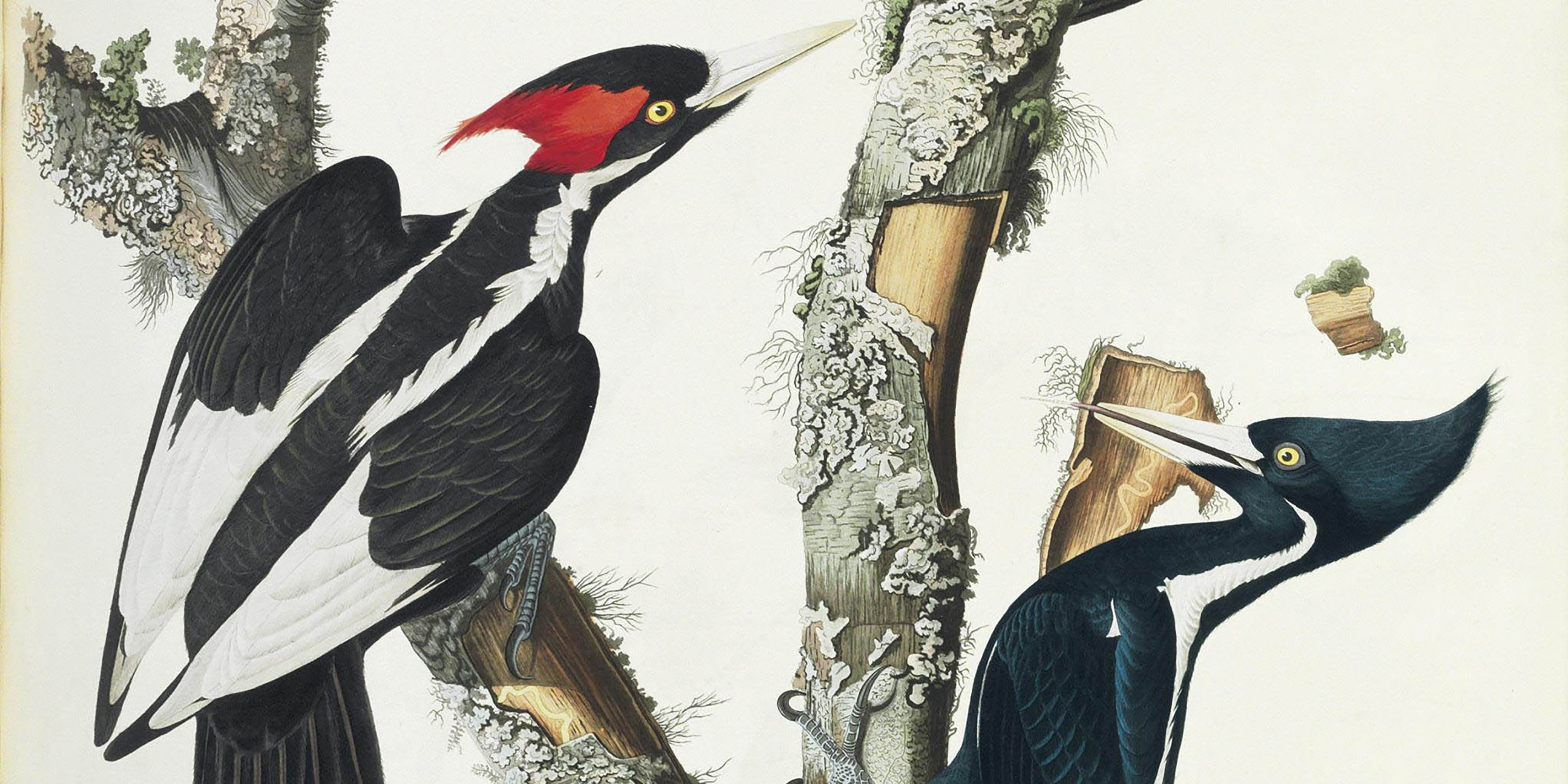Originally published 30 June 1986
The ivory-billed woodpecker lives!
That is the announcement made several weeks ago by ornithologist Lester Short of the American Museum of Natural History. Short and his colleagues sighted several ivory-billed woodpeckers in the mountain forests of eastern Cuba. It was the first undisputed sighting of the woodpeckers in Cuba since the 1970s. Most ornithologists had considered the bird to be extinct.
The ivory-billed woodpecker was once common in the southeastern United States. It is a large bird with a wing-span of nearly three feet. It has shiny black plumage marked by distinctive white stripes, white-tipped wings, and a magnificent scarlet crest. And of course the long ivory bill that gives the bird its name. In Audubon’s painting of a male and two females, the birds have something of the look of a family of gaily-colored pterodactyls. Audubon frequently observed ivory-billed woodpeckers. Like them, he loved the solitude of wild forested places.
The ivory-billed woodpecker’s range once included most of the Atlantic and Gulf Coastal Plains, from the Carolinas to Texas, and much of the Mississippi Valley. Extensive foresting, especially along river bottoms, destroyed the bird’s natural habitat and the supply of wood-boring beetles that were its chief food. The last undisputed sighting of an ivory-billed woodpecker in the United States was in 1941. Since that time, there have been occasional rumors of sightings in Louisiana swamps or Texas thickets, but even the rumors have become increasingly rare.
The ornithologist Frank Chapman described the call of the ivory-billed woodpecker as “the distant note of a penny trumpet.”
There are no more penny trumpets, but apparently there are still a few ivory-billed woodpeckers toot, toot-tooting in sunny Cuba. Now they have been found out. The Cuban government has promised to restrict logging in the area where the birds were sighted. It is not known to what extent they will restrict the expected influx of bird-watchers. The latter may be as detrimental to the bird’s solitude as the former.
Woodpecker not first to return
Supporters of legislation to protect endangered species rightly emphasize that extinction is forever. When something is as dead as a dodo, it is dead indeed. No one expects ever again to see a live dodo or a live passenger pigeon. A lot of people never expected to see another ivory-billed woodpecker. But that bird, it turns out, can legitimately say with Mark Twain: “Reports of my death have been greatly exaggerated.”
The ivory-billed woodpecker is not the only animal that has returned from “extinction.” The most celebrated case is the coelacanth. For years this remarkable fish was known only by its fossils, fossils that were tens or hundreds of millions of years old. The coelacanth is one of the primitive lobe-finned fish from which all vertebrates are descended. It was thought to have become extinct at the same time as the dinosaurs.
Then, in 1938, to everyone’s surprise and consternation, a coelacanth was caught by fisherman off the coast of Africa. The catch threw the scientific world into a tizzy. It was as if a fossil on a museum shelf had suddenly come to life. A search of the same waters failed to produce another specimen. It wasn’t until 1953 that a second coelacanth was pulled from the sea near the Comoro Islands in the Indian Ocean. Since that time, dozens of coelacanths have been found and studied.
The strange story of the coelacanth supports the always fascinating possibility of creatures returning from the dead. But sometimes reports of a resurrection are greatly exaggerated.
Consider the Loch Ness Monster. An astonishing number of people in Britain — and elsewhere — are convinced that a sizable monster lives in the cold depths of that Scottish lake. The most widely-held theory is that Nessie (as the monster is affectionately called) is a plesiosaur, a sea-going dinosaur that scientists say has been extinct for 63 million years. According to Nessie enthusiasts, a plesiosaur has somehow managed to survive in the cold dark waters of Loch Ness, just like the coelacanth.
Science fiction becomes fact
Few, if any, serious scientists believes a plesiosaur, or anything like it, lives in Loch Ness. For one thing, only ten thousand years ago Loch Ness was filled with ice. Still, everyone loves the thought of a survivor. Tens of thousands of dollars have been spent trying to acquire definitive evidence for the existence of a plesiosaur in Loch Ness, so far without success. We have seen dozens of science fiction movies about remote islands populated with dinosaurs and other monsters from the past.
In a modest sort of way, the ivory-billed woodpecker has turned science fiction into science fact. Perhaps the rediscovery of that elusive bird is not so grand a story as the discovery of a South Sea island full of dinosaurs — but for the ivory-billed woodpecker, it is the best story of all.
Since this essay was first published, there have been sporadic but unconfirmed sightings of the Ivory-billed woodpecker in the Southeastern U.S. and Cuba, including some fleeting glimpses of a suspected specimen in Arkansas in 2004. The bird is categorized as critically endangered by the IUCN. ‑Ed.



